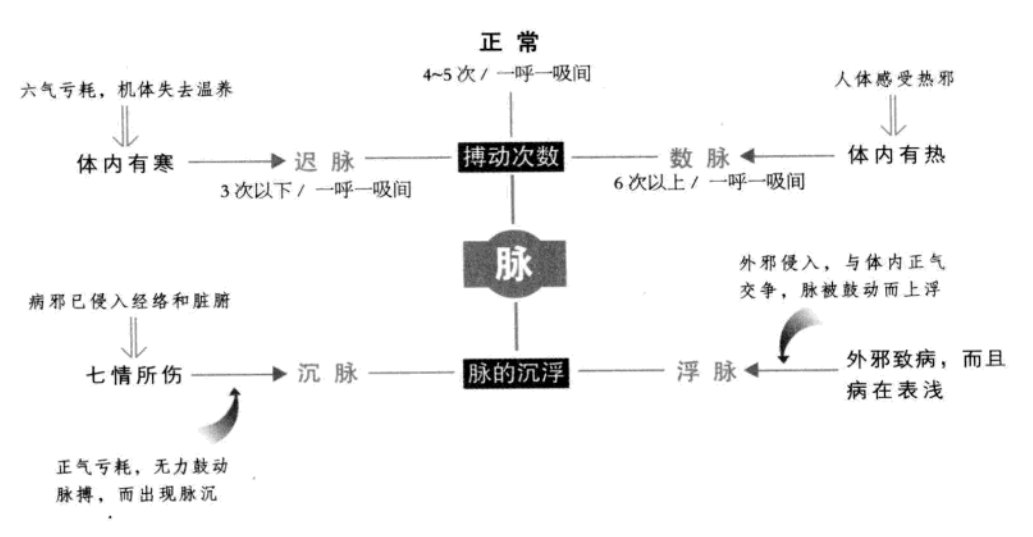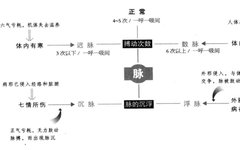 TCM Case Studies / Medical Discussions / Reference Articles for Learning Clinical TCM
TCM Case Studies / Medical Discussions / Reference Articles for Learning Clinical TCM Introduction: Mastering the four basic pulse types: floating, sinking, slow, and rapid is essential for making connections when diagnosing through pulse examination.
Introduction: Mastering the four basic pulse types: floating, sinking, slow, and rapid is essential for making connections when diagnosing through pulse examination.
Distinguishing diseases based on the four basic pulse types and their relation to exterior/interior and cold/heat
During pulse diagnosis, the practitioner must first stabilize their own breathing, then use their breath count to assess the patient’s pulse rate. The standard for a normal pulse is four to five beats between each inhalation and exhalation.If there are only three beats, it is termed a slow pulse (chi mai). The presence of a slow pulse indicates the presence of cold evil within the body. If there are six beats, it exceeds the normal pulse count, which is called a rapid pulse (shuo mai). The presence of a rapid pulse indicates the presence of heat evil. If the pulse beats only once or twice, this is even slower than a slow pulse, indicating severe accumulation of cold evil within the body. Similarly, if the pulse beats seven or eight times between breaths, it indicates severe accumulation of heat evil.Understanding the characteristics of slow and rapid pulses and how to diagnose based on pulse speed is crucial, as is understanding the characteristics of floating (fu mai) and sinking (chen mai) pulses and how to diagnose using them. Only then can one clearly determine whether the disease is caused by external evils or by the internal emotions of a person.External evils refer to the six types of pathogenic factors: wind, cold, heat, dampness, dryness, and fire.In normal circumstances, wind, cold, heat, dampness, dryness, and fire are natural climatic changes formed by different meteorological factors in nature, and humans have adapted to these changes.However, there is a limit to everything; if the changes in these six factors exceed the range that the human body can adapt to, they become pathogenic and can cause disease.These pathogenic factors are often quite strong, and once they invade the body, they engage in a fierce struggle with the vigorous righteous qi, causing the pulse to become strong and floating, which manifests as a floating pulse. The appearance of a floating pulse indicates a fierce struggle between the righteous and evil qi, suggesting a superficial disease with a relatively mild condition.Internal causes refer to the seven emotions: joy, anger, worry, thought, sadness, fear, and shock.Similarly, under normal circumstances, these seven emotions do not harm the body, but when they become excessive, they can deplete the body’s righteous qi. When the righteous qi is depleted and unable to effectively drive the pulse, the pulse becomes less pronounced, manifesting as a sinking pulse.Therefore, during diagnosis, by observing whether the patient exhibits a floating or sinking pulse, one can first determine whether the pathogenic factor is internal or external, whether it is a solid pattern (shi zheng) caused by external factors or a deficiency pattern (xu zheng) caused by internal factors. This method of judgment is still widely used by practitioners today.In summary, if a sinking pulse is observed, it indicates that the pathogenic evil has invaded the body, often due to internal emotional stagnation, qi stagnation in the interior, leading to disharmony of the organ qi mechanisms, indicating a deeper condition (li zheng); if a slow pulse is observed, it often indicates deficiency of the original qi, leading to a loss of warmth in the body, a deficiency cold condition, also known as a yin condition; if a rapid pulse is observed, it often indicates that the body has been affected by heat evil, with the evil heat being intense, scorching the yin fluids, known as a yang condition.If a floating pulse is observed, it is often due to the invasion of external evils, but if the disease is superficial, it is a superficial condition (biao zheng). A floating pulse can also appear due to emotional injuries, often indicating deficiency of yin blood, leading to internal wind movement due to the loss of nourishment from liver blood.The broad concept of the six evils not only refers to the excessive six qi, but also includes infectious diseases or pathogenic factors that differ from general climatic anomalies. Later practitioners distinguished these using the term “poison,” such as wind poison, fire poison, damp poison, dry poison, cold poison, and heat pollution.Thus, when discussing the six evils in terms of external causes, it encompasses two points: one is the change in climate, and the other is the presence of evil toxins.For example, taking cold as an example: cold evil can refer to excessively low temperatures causing frostbite, or a sudden drop in temperature leading to wind-cold colds, or cold winter weather causing cough with phlegm or joint pain; these are all injuries caused by climatic changes; the second refers to infectious diseases. As stated in the “Suwen: Discussion on Heat,” the so-called heat diseases are generally of the cold injury type… when a person is harmed by cold evil, they will develop a fever. This indicates that cold evil is a major cause of certain infectious diseases and heat diseases, where the cold evil here is clearly not referring to general cold temperatures.However, the pulse manifestations of the lungs are often not singular and unchanging, but rather complex and multifaceted. For instance, a slow pulse can be further divided into floating slow and sinking slow. Floating slow indicates that the deficiency cold is on the surface, while sinking slow indicates that cold evil has penetrated deeply. Similarly, a rapid pulse can be divided into floating rapid and sinking rapid, where floating rapid indicates that the degree of heat evil invading the body is still relatively superficial, while sinking rapid indicates that heat evil has penetrated the meridians and organs.Therefore, the examination of pulse manifestations is not simply floating or sinking, rapid or slow, but requires careful examination, mutual reference, comparative analysis, and differentiation of the degree of pathogenic invasion, whether it is superficial or deep, whether it is deficiency or excess, whether it belongs to yin or yang, whether it is wind or qi, whether it is cold or heat, whether it is an internal injury or an external invasion.While pulse diagnosis may seem very complex, as long as one masters the floating, sinking, slow, and rapid pulse types and uses them as a framework, one can make connections when diagnosing through pulse examination!There are countless diseases, but pulse types are limited, and different diseases may exhibit the same pulse type, while the same disease may present multiple pulse types. Therefore, when diagnosing pulses, one must be meticulous and cannot simply conclude based on the diagnosis of a single pulse type; multiple pulse types must be mutually referenced and analyzed to achieve an accurate diagnosis.
From the speed and depth of the pulse, one can discern the location of the disease and the body’s cold and heat conditions.
Identifying pulse types primarily relies on the sense of touch of the fingers.In modern TCM, there are twenty-eight pulse types used clinically, mainly reflected in aspects such as position, count, shape, and momentum. These aspects are categorized based on factors such as pulse frequency, rhythm, the location, length, and width of the pulse, the fullness and tension of the pulse vessels, the smoothness of blood flow, and the strength of the heart’s beats.For instance, floating and sinking refer to different pulse positions, slow and rapid refer to different counts, deficiency and excess refer to differences in strength, while flooding pulse and thin pulse refer to differences in shape and momentum. Although there are 28 pulse types, they can all be categorized based on the four aspects of position, count, shape, and momentum. Mastering the elements of pulse types can simplify the understanding of the characteristics and formation mechanisms of various pulse types.Note:Please follow medical advice for specific treatments and medications!This article is excerpted from “Li Shizhen’s Teachings on Pulse Diagnosis“, Wang Jiran, Zhang Li Interpretation, Chongqing Publishing House, 2010.2.You may also like, click to read the original text:5 summaries of women’s pulse types, which can not only differentiate pregnancy but also determine the month!Zhang Zhiyuan: Three wonderful medicines for treating uterine bleeding: Di Yu, Guan Zhong, Bai Tou Weng////////// #Introduction to TCM Collection
#Introduction to TCM Collection


